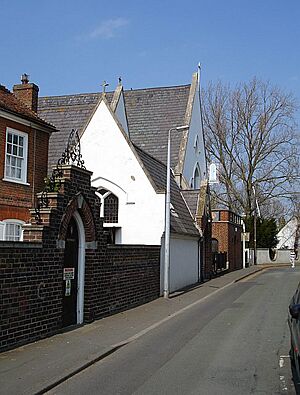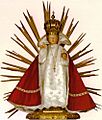National Shrine of Saint Jude (England) facts for kids
Quick facts for kids National Shrine of Saint Jude, Faversham |
|
|---|---|

Tanners Street
|
|
| 51°18′55″N 0°53′03″E / 51.31524°N 0.88424°E | |
| Location | Faversham, Kent |
| Country | |
| Denomination | Roman Catholic |
| Website | http://www.stjudeshrine.org.uk |
| History | |
| Status | Active |
| Founded | 1955 |
| Founder(s) | Fr Elias Lynch, O.Carm |
| Dedication | Saint Jude |
| Dedicated | 28 October 1955 |
| Relics held | Saint Jude |
| Architecture | |
| Style | Post War/Modern |
| Administration | |
| Parish | Our Lady of Mount Carmel |
| Deanery | Canterbury |
| Archdiocese | Southwark |
The National Shrine of Saint Jude is a special place in Faversham, Kent, England. It's a shrine dedicated to Saint Jude. Many Catholics and other Christians visit it for prayer. It officially opened in 1955. The shrine is part of the Roman Catholic Archdiocese of Southwark. It was started by the Order of Carmelites. You can find it on Tanners Street.
Contents
History of the Shrine
The oldest building on the church site is an 18th-century mansion. It was built for a local tanner. Since 1936, it has been called "Whitefriars." This building is where the Carmelite priests live. It is next to the church and the shrine. This mansion is a Grade II listed building, meaning it's historically important.
The church building itself dates back to 1861. It was first used as a schoolroom. Quaker girls, whose parents worked in local gunpowder factories, studied there. You can still see marks on the walls where children sharpened their slate pencils. The school closed in 1907.
In 1910, a company bought the building. They turned it into a cinema called The Empire Picture Hall. The cinema closed in 1936. The Carmelites then bought the building. By 1937, they had changed it into a church. The original church on Plantation Lane had to close.
Building the Shrine
In 1955, the Shrine of Saint Jude was built. It was placed next to the church. This building was made specifically for people to visit and pray. On October 28, 1955, the shrine was officially opened.
The Bishop of Southwark, Cyril Cowderoy, helped with the opening. Many other priests and friars were there. Bishop Cyril called the shrine "a jewel for the diocese."
Inside the Shrine
A corridor connects the church and the shrine. This corridor has beautiful stained glass windows. These windows were made by the artist Richard Joseph King. They show important figures from the Carmelite Order.
One window shows Saint Simon Stock. He was from Kent and became a leader of the Carmelite Order. Other windows show Saint Brocard, the prophet Elisha, and the prophet Elijah.
The inner shrine has a statue of the Apostle Jude. It is from the 15th century. The statue is made of wood and has gold and colors. It was a gift from Mr. and Mrs. Murphy. They gave it to remember their sons, Matthew and Michael. Both sons died fighting in the Second World War.
Michael Leigh A.R.C.A. designed parts of the shrine. He designed the mosaic apse, the ironwork, and the outside mosaic frieze. He also worked on other churches, including Westminster Cathedral.
The inner shrine also holds a special container called a reliquary. It is called the Augsberg Reliquary. This is a modern copy of an old silver container from 1547. The reliquary was changed to hold a relic. A relic is a small piece, in this case, a bone fragment, of Saint Jude.
The artist Adam Kossowski created three designs for the shrine. These include holy water stoops at the entrance. He also made three ceramic plaques.
There are also icons, which are religious paintings. They show different saints. One icon shows Saint Albert giving the Carmelite 'way of life' to Saint Brocard. Others show Blessed John Soreth and Blessed Françoise d'Amboise. There are also icons of Saint Elias Kuriakos Chavara and Blessed Isidore Bakanja. Finally, there are icons of Blessed Titus Brandsma and Saint Edith Stein.
Fire at the Shrine
In 2004, a fire started in the shrine chapel. The fire destroyed the murals. It also damaged much of the other artwork. The windows and ceramic pieces could be fixed. However, the murals had to be replaced.
It was decided to put up new icons. These icons show saints who were inspired by the Carmelite Rule. This was done to celebrate 800 years of the Carmelite Rule in 2007. Sister Petra Clare, a Benedictine hermit from Scotland, painted these icons.
Activities at the Shrine
The Society of the Infant Jesus is connected to the Shrine of the Infant Jesus. This shrine is cared for by Carmelite brothers in Prague. The original statue of Jesus there has been honored since the 17th century.
In 2014, the Guild of Saint Jude was started. This group helps people worship. Members support the Carmelite Family through prayer and donations. They also help tell people about the National Shrine. The Guild encourages more people to visit the shrine.
In 2020, the British Pilgrimage Trust wrote about the Faversham Shrine. They said it was a good place for Anglicans and Catholics to meet. They felt that Saint Jude was a better figure to think about than other historical figures. For these reasons, they highly recommended the shrine.
During the pandemic in 2020 and 2021, the Shrine of Saint Jude offered online activities. These included 'Praying with Saint Jude at home.' They also held a Virtual Feast of Saint Jude. Carmelite friars, lay people, and others connected to the shrine took part.
Two main events happen at the shrine each year. One is in May, and the other is in October. The October event is on the feast day of Saint Jude.
Images for kids



